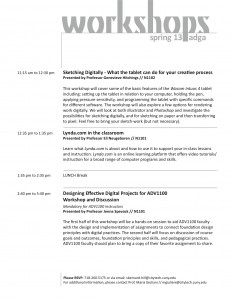On Wed. January, 23rd I will be facilitating a workshop for all faculty teaching ADV1100: Graphic Design Principles 1.
After teaching Web Design for my first six years at City Tech and observing that only a minority of students appeared to have grasped basic design principles and concepts by the time they reached their concentration classes, I asked the Department Chair if I could teach the foundation class Graphic Design Principles 1 (formally known as Design and Color).
My aim was to explore how this course was taught and try to find ways for our students to successfully translate the basic design principles learned in ADV1100 in upper-level courses. It was a mystery to me how some students could produce strong hand work in their first semester and weak digital work in subsequent years.
What was causing this disconnect?
- insufficient exposure to digital tools in their foundation courses?
- a focus on a “fine art” rather than “design” approach in foundations?
- lack of consistency across the course curriculum? ie: each faculty was teaching a different set of principles?
- the principles were not being reinforced in upper-level courses, beyond foundation year?
These are things I have been trying to explore for about two years. My attempts to actively collaborate and collectively explore this challenging issue have been slowed by OpenLab directorship duties, a year-long sabbatical, and the challenges of coordinating adjunct ADV1100 faculty meetings during a busy semester. I set up the ADV1100 Instructional Resource project on OpenLab to encourage faculty to contribute, but with only a few digitally-confident faculty, I haven’t been able to jump start a dialog.
At the start of this workshop ADV1100 faculty will discuss the course goals and learning outcomes, foundation principles and skills, and pedagogical practices that they are currently using and compare those with the department’s master syllabus. Together I would like to propose a set of learning outcomes based on our current curriculum, student needs, and lack of computer access and work together over the semester to improve the master syllabus.
Next I will present some small digital tasks that faculty can introduce into their class assignments throughout the semester. Rather than ask students, many of whom are not yet skilled in digital tools, to complete an entire assignment in Photshop, Illutrator or InDesign faculty can introduce the basic use of these tools as part of a larger project. Other faculty members are encouraged to post their example tasks to the ADV1100 Instructional Resource.
Examples might include using Photoshop or Illustrator to:
- create proportional color inventory
- recreate a simple paper collage project
- scan and trace a sketch
- create Simultaneous Contrast pairings
Lastly, we will work together to propose pedogogical solutions that still allow basic design principles to be explored through experimentation and traditional skills, but also find ways of creating a “bridge” to real-world design projects. I would like the group to come up with two digital bridge assignments that will act as stepping stones into the next course: ADV1200 Graphic Design Princples 2.
These projects should address the following principles:
- Structural Thinking (ie: Organizational Frameworks, Planning Systems, Visual Filling Cabinet, The Grid)
- Visual & Information Hierarchy (ie: Classification, Data Chunking, Visual and Conceptual Order)
- Proportional Color (ie: Schemes, Palettes, Inventories)
EXAMPLE: Ask students to deconstruct a magazine layout, web page, game interface, etc. and reduce the structure down to a grid framework and limited color palette. Essentially a page of hierarchically ordered colored boxes. Ask students to identify the information hierarchies and explain how they are supported by the visual design choices (color, proximity, scale, balance etc.). Ask students to create a proportional color inventory of this deconstructed framework and show how the palette is used to reinforce information hierarchy and create a unified composition.
I strongly believe that students NEED a course that gives them the freedom experiment and fail- to think creatively and challenge their beliefs about what is possible. This is hugely important for the majority of our students, many of whom come to us from the public school system and have never been asked to “invent” a solution to a problem and partake in a collaborative design process. ADV1100 is only class that allows that freedom to experiment and fail. I hope we can allow this exploration, but also find ways of translating the basic concepts of design to the real-world practice.
—
Documentation:
